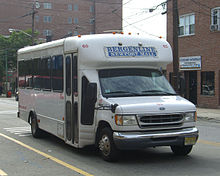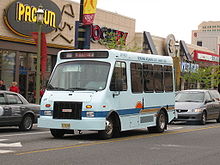- Dollar van
-
A dollar van (also known as a commuter van, jitney) is a privately owned type of bus service used to carry passengers in the United States of America. Dollar vans typically operate in neighborhoods within urban areas that are under-served by public mass transit or taxis. Some of the dollar vans are licensed and regulated, while others operate illegally. Passengers may board them at designated stops along their route or hail them as share taxis (although the latter practice may be technically illegal). The name comes from the fact that it would only cost about one dollar or so to ride with such transit. Dollar vans are primarily owned and used by inner-city African/Caribbean American, Latino, and Asian American populations. The vehicles used range from 15-seat Ford Econolines to 29-seat minibuses.[citation needed] Travelers cite cost and greater frequency as factors in choosing jitneys over larger bus service, whereas safety and comfort are cited for choosing buses.
Contents
New York City and Northern New Jersey
New York has many forms of semi-formal public transportation, including "dollar vans" and "Chinese vans." Dollar vans serve major corridors in Brooklyn, Queens and the Bronx that lack adequate subway service. In 2006, the New York City Council began debate on greater industry regulation, including requiring all dollar vans to be painted in a specific color to make them easier to recognize, similar to the public light buses in Hong Kong.[1] The vans pick up and drop off anywhere along a route, and payment is made at the end of a trip. During periods when even limited public mass transit is unavailable, such as the January 2005 Green Bus Lines and Command Bus Company strike or the December 2005 New York City transit strike, dollar vans may become the only feasible method of transportation for many commuters.In such situations, city governments may pass legislation to deter price gouging.
In New Jersey, 6,500 jitney buses are registered, and are required to have an "Omnibus" license plate, which denotes the vehicle's federal registration. They are also required to undergo inspection by the state MVC mobile inspection team on the vehicles' companies' property twice a year, and be subject to surprise inspection. Drivers of jitneys are required to qualify for a Class B or Class C Commercial Drivers License (CDL), depending on whether the vehicle seats up to 15 or 30 passengers. Violations against a driver's CDL must be resolved and result in payment of fines prior to resumption of driving on the driver's part, with retesting required if the driver waits longer than three years to resolve the issues.[2]
Denser urban areas of northern New Jersey, such as Hudson, Bergen and Passaic County, are also served by dollars vans,[3][4] which are locally known for their Spanish language name guagua (pronounced "gwah-gwah").[5] Nungessers, along the Anderson Avenue-Bergenline Avenue transit corridor is a major origination/termination point, as are 42nd Street in Manhattan, Newport Mall and Five Corners in Jersey City, and GWB Plaza in Fort Lee.[6]
Travelers cite safety, comfort, reliability and cost as factors in choosing jitneys over larger bus service. Hudson County commuters who prefer NJ Transit buses, for example, cite senior citizen discounts and air conditioning among their reasons, though jitney operators employ bumper stickers indicating air conditioning aboard their vehicles. Some who prefer the buses will nonetheless take the jitneys if they arrive before the buses, as they pass bus stops more frequently than the buses, and are cheaper. Others choose buses because, they claim, jitney drivers are less safe, and are prone to using cell phones and playing loud music while driving. Although Union City jitney driver Samuel Martinez has complained that authorities unfairly target them and not the larger buses, North Bergen Patrol Commander Lt. James Somers has contended that jitneys are less safe, and sometimes exhibit higher levels of aggressive driving in order to pick up passengers, which has led to arguments among drivers. Somers also stated that police can only stop a vehicle that appears to have an obvious problem, and that only certified inspectors from the state MVC can stop a vehicle for less apparent, more serious problems.[2]
Over the course of the 2000s, surprise inspections in Hudson County have been imposed on jitney operators, whose lack of regulation, licensing or regular scheduling has been cited as the cause for numerous fines. A series of such inspections of the vans on Bergenline Avenue in June 2010 resulted in 285 citation violations, including problems involving brake lights, bald tires, steering wheels, suspensions, exhaust pipes, and emergency doors welded shut. An early July 2010 surprise inspection by the Hudson County Prosecutor's Office, which receives federal funding for regulating jitneys, found 23 out of 33 jitneys to be unsafe, which were taken out of service.[2][7] Claims have also been made that jitneys cause congestion and undermine licensed bus service.[8]
See also
References
- ^ Lueck, Thomas J. (2006-03-30). "New Yorkers May Soon Be Able to Tell A Van, as They Do a Cab, by Its Color". New York Times. http://query.nytimes.com/gst/fullpage.html?res=9B01E4D81530F933A05750C0A9609C8B63. Retrieved 2010-02-24.
- ^ a b c Tirella, Tricia. "Fierce competition surrounds jitney buses". The Union City Reporter. July 25, 2010. Pages 1 and 9
- ^ Minutes of the Meeting Of the Historic New Bridge Landing Park Commission; March 6, 2008
- ^ Cowen, Richard & Bautista, Justo. "Police arrest 7 in jitney hijacking" The Bergen Record; November 3, 2006
- ^ "Best Things to do in Secaucus NJ New Jersey" Hotel Planner; Accessed August 7, 2010
- ^ Hudson County Bus Circulation and Infrastructure Study (PDF file) HudsonCountyNJ.org; Prepared for Hudson County Division of Planning; June 2007; Accessed August 7, 2010
- ^ Hague, Jim. "Erratic driving, lack of licensing: Prosecutor's Office cracks down on commuter vans" The Hudson Reporter; May 13, 2007
- ^ Hudson County Master Plan: Chapter IV: Circulation Plan HudsonCountyNJ.org; Accessed August 7, 2010
External links
- Dollar van definition
- Long Stalemate Expected After Union Quits Strike Negotiations, Queens Chronicle, Jan. 20, 2005 (dollar van price gouging during Jan. 2005 strike).
- Crowds Overrun LIRR Station While Traffic Crawls In Jamaica, Queens Chronicle, Dec. 22, 2005 (dollar van use during Dec. 2005 strike).
- Council Eyes Color Coding To Make ‘Dollar Vans’ Safer, Queens Chronicle, Apr. 6, 2006.
Categories:- Share taxis
- Bus transportation in the United States
- Transportation in New York City
- Bus transportation in New Jersey
Wikimedia Foundation. 2010.


